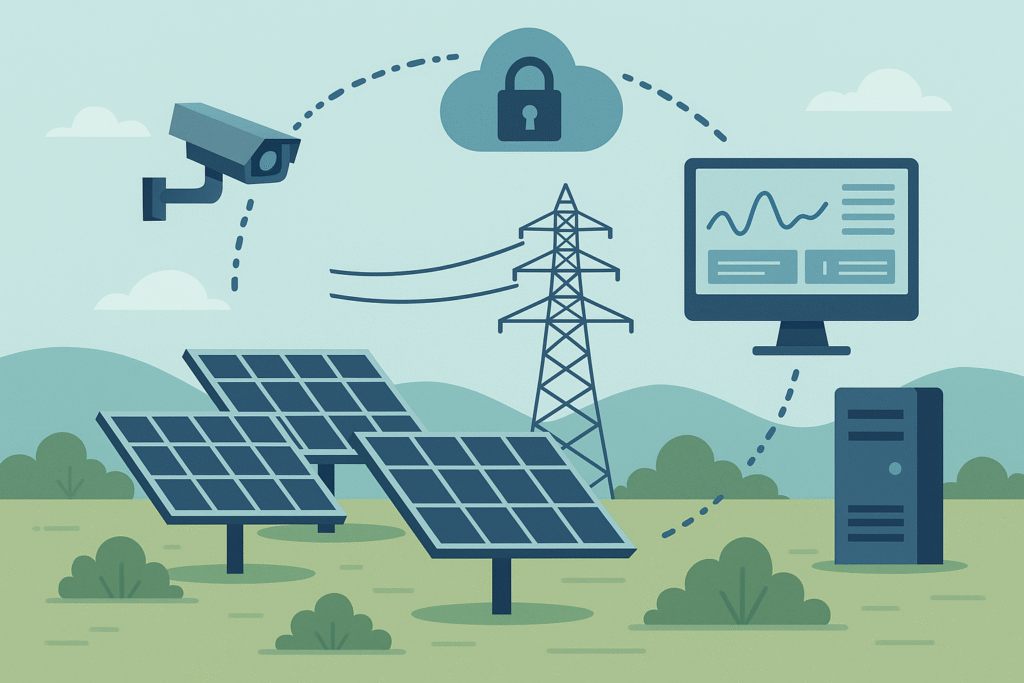
As the United States accelerates its transition toward clean energy, solar farms have emerged as a backbone of this new power economy. Vast fields of photovoltaic (PV) panels now generate gigawatts of electricity, feeding homes, industries, and critical facilities. But while solar technology promises sustainability, it also introduces new vulnerabilities. Beyond environmental factors like storms or dust, the most pressing risks today often come from the invisible world of cyber-physical threats.
The resilience of America’s solar farms now depends not just on robust hardware, but also on secure digital infrastructure. Protecting these assets requires integrating cybersecurity with renewable energy operations — a domain often referred to as cyber-physical resilience.
The Growing Importance of Solar in U.S. Energy Security
Solar power is the fastest-growing source of electricity in the United States. According to the Department of Energy (DOE), solar is projected to supply 40% of the nation’s electricity by 2035 if deployment continues at scale. Large-scale PV farms are central to this growth, representing thousands of acres of solar modules connected through inverters, communication systems, and supervisory control and data acquisition (SCADA) networks.
These systems don’t operate in isolation. They interact with:
- The broader power grid, balancing fluctuating solar generation with demand.
- Energy storage systems that stabilize output during cloudy periods.
- Remote monitoring and control platforms that optimize performance.
While this connectivity improves efficiency, it also creates pathways for cyber intrusion.
Understanding SCADA and Its Role in Solar PV
SCADA (Supervisory Control and Data Acquisition) is the digital nervous system of most modern solar farms. It allows operators to:
- Monitor inverter health, energy output, and battery status in real time.
- Send commands to adjust system performance or reroute energy.
- Automate fault detection and emergency shutdowns.
In effect, SCADA systems turn solar farms into smart, responsive infrastructure. But because they rely on interconnected sensors, servers, and communication channels, they are also vulnerable to malicious attacks.
Cyber-Physical Threats Facing Solar Farms
Several categories of cyber threats could jeopardize solar PV infrastructure:
- Unauthorized Access
Hackers could exploit weak authentication systems to gain control of solar inverters or controllers, disrupting energy flow or causing shutdowns. - Data Manipulation
Attackers might alter performance data, leading operators to make incorrect decisions about grid balancing or equipment health. - Distributed Denial of Service (DDoS)
Flooding SCADA communication channels with traffic could paralyze remote monitoring platforms, leaving operators blind during critical events. - Malware and Ransomware
Infected systems could lock out operators until payments are made or data is restored, causing prolonged outages. - Coordinated Physical-Cyber Attacks
Cyber intrusions combined with targeted physical sabotage could cripple large portions of a solar farm, with cascading effects on the grid.
These scenarios are not hypothetical. In 2021, the Colonial Pipeline cyberattack underscored the potential of cyber threats to disrupt critical infrastructure. Energy systems, including renewables, are no exception.
The Cost of Inaction
Failure to address these vulnerabilities could have severe consequences:
- Energy Reliability: A single cyber breach could cause cascading blackouts if a solar farm is integrated into regional grid operations.
- Economic Impact: Downtime leads to lost revenue for developers, higher costs for utilities, and ripple effects across industries dependent on stable electricity.
- Public Trust: Repeated attacks could erode public confidence in renewable energy’s role as a secure alternative to fossil fuels.
- National Security: Solar farms, particularly those near military or industrial hubs, could become targets in geopolitical conflicts.
Building Cyber-Physical Resilience
Protecting solar farms requires a multi-layered defense strategy, combining traditional engineering with cybersecurity best practices. Some essential measures include:
- AI-Powered Anomaly Detection
Machine learning models can monitor SCADA data streams in real time, flagging unusual patterns that may indicate intrusions or malfunctions. - End-to-End Encryption and Authentication
Ensuring secure communication between sensors, inverters, and central servers prevents unauthorized access. - Redundant Control Systems
Backup control mechanisms can keep operations running during cyber disruptions. - Regular Penetration Testing
Simulated attacks help identify vulnerabilities before real adversaries exploit them. - Operator Training and Awareness
Human error remains one of the biggest risks. Training staff in cybersecurity protocols reduces the chance of breaches through phishing or weak password practices. - Policy and Standards Alignment
The National Institute of Standards and Technology (NIST) and DOE Cybersecurity for Energy Delivery Systems (CEDS) program offer frameworks that solar developers should adopt.
The Role of GridNova Technologies
Companies like GridNova Technologies, founded by researcher and engineer Fozlur Rayhan, are working to embed cyber-physical resilience directly into renewable energy solutions. GridNova’s approach integrates:
- Secure SCADA platforms with cloud-enabled anomaly detection.
- AI-based diagnostics to predict and prevent equipment failures.
- Resilience tools for mitigating cyberattacks on distributed energy systems.
By aligning with DOE’s Grid Modernization Strategy and national priorities in cybersecurity, these innovations ensure that solar farms can scale without compromising security.
Conclusion
America’s clean energy future depends not only on how much renewable power we install but also on how well we protect it. Solar farms, as critical assets in this transition, must be secured against both physical and digital threats. Cyber-physical resilience — built through AI monitoring, SCADA security, and strong federal alignment — will determine whether solar can deliver on its promise of reliable, sustainable power.
The stakes are high: without resilience, cyber threats could undermine decades of progress in renewable energy. With it, solar power can stand as a pillar of both sustainability and security in the decades ahead.
